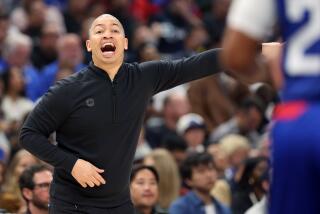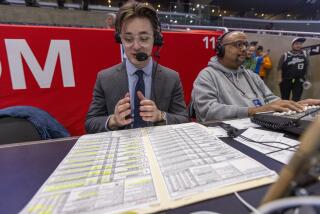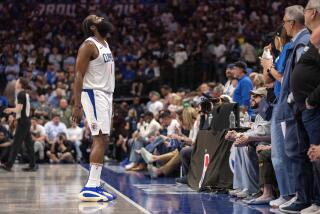Harper Has Last Laugh : Clippers: Former Cavalier overcomes early speech problems to make it in the NBA.
- Share via
The man with a lightning bolt shaved into the hair on his right temple and thunder in his legs knows all about playing with pain. He’d done just that for most of his 25 years.
In school, he hated it when teachers called on him to read aloud. He found comfort on the basketball court, even though his future in the game looked about as bright as his chances of making the Social Register.
Long conversations?
Forget it.
“For a kid growing up with a speech problem, you might as well be in jail,” Ron Harper said. “Jail is a lot easier.”
Harper grew up with a speech problem. From elementary school through junior high to high school, peers mocked him, laughing as he stammered and stuttered through sentences. Basketball was an outlet, one of the few activities in which the youngest of six kids raised by a single mother in Dayton, Ohio, could find self-respect.
He wasn’t much good at basketball, either--the 12th man on the freshman team at Dayton’s Belmont High, whom the coach told that next season he’d be welcome to come out, but don’t expect to play.
Ron Harper transferred across town to Kiser High, a smaller school with about 325 students. He made the team, gained confidence and earned a scholarship to Miami of Ohio. He was a first-round draft choice of the Cleveland Cavaliers, the eighth player picked in 1986.
By the week before last, when Harper came to the Clippers in a trade that included three former first-round selections and two in the future, he was better than ever, in several ways. He doesn’t shy away from talking to people, strangers even, and oh, how people like talking about him.
“In the transition game, he’s as good as Michael Jordan,” said Don Chaney, coach of the Houston Rockets. “And that’s not an understatement. He can do everything Michael can do in that phase of the game--handle the ball, run and dunk, and be quick enough to pull up for the jumper or go by the defender on a drive.”
That only makes Harper one of the best off-guards in the world. Get past Jordan, and it becomes dealer’s choice among Dale Ellis of Seattle, Clyde Drexler of Portland, Byron Scott of the Lakers, Joe Dumars of Detroit, Rolando Blackman of Dallas and Harper, who last season averaged 18.6 points and blocked more shots than any guard and eight starting centers.
“He can fly through the air,” Blackman said of Harper. “He’s a very acrobatic guy, a guy you have to contend with every time he’s on the court.”
The Clippers became believers some time ago. They had pursued Harper for six months before finally sending Reggie Williams and the rights to Danny Ferry to Cleveland for Harper plus a No. 1 draft choice in 1990, a No. 2 in ’91 and a No. 1 in ’92.
The appeal was obvious. Harper, a 6-foot-6 1/2, 198-pounder, is only 25, yet has already been in the playoffs twice in a three-year career, averaging 18.8 points in nine games. He went into this, his fourth season, with a career average of 19.4 points, and although the major knock against him is his outside shooting, he had improved from 45.5% to 46.4% to 51.1% from the field each season. In the first seven games with Cleveland this season, he averaged seven assists and 6.9 rebounds.
Clipper General Manager Elgin Baylor calls Harper a basketball junkie, with the perfect blend of experience and youth. Lenny Wilkens, his coach at Cleveland, talked of Harper’s court sense in knowing everyone’s role on every play, not just his own. Cavalier center Brad Daugherty said Harper plays to the fans and feeds off their energy. Blackman said the best defense against Harper is simply not to let him have the ball.
The Cavalier players had the day off when Baylor called to discuss the trade with Harper, who happened to be on his way out the door to play basketball. Baylor enjoyed that, but he shouldn’t have been surprised. Harper plays basketball the way some people chain-smoke. It’s an appetite more than something to do.
He was the kid that neighbors would tell to knock off the racket and go to sleep--it was 2 a.m., for goodness sakes. He and four older brothers would often play for so long in the back yard of their home in Dayton’s ghetto neighborhood that they would start when the ground was covered by grass and go until it was Pig Pen regulations--on a court of dirt and dust. Snow was not a deterrent, either.
This was Harper’s place to stand out, even if he was around only because of persistence, rather than talent. He could handle getting a shot blocked by a brother eight years his senior better than feeling the stares while struggling through a response to a teacher’s question. Nobody laughs when the best answer is swishing a ball through the net-less bent rim.
“It gave me a chance to express myself,” he said. “Once I got on the court, I always felt away from things. I felt comfortable. When I was on the court, I would lose all my problems.
“I think everything changed for me once I got a lot of confidence in my basketball game. Off the court, when I had a good game the day before, I turned that into positive energy. That was the key.”
Harper, who became a college prospect after growing from 5-10 to 6-2 1/2 between his sophomore and junior seasons in high school, began to concentrate on correcting his impediment. He picked Miami of Ohio because of its proximity to home--Oxford is 45 miles southwest of Dayton--and its emphasis on a good speech program. There, coaches and publicists limited his media exposure the first year, waiting until he felt completely comfortable before accepting all requests.
By the time Harper left the university in 1986, he was able to handle the attention. Playing wasn’t nearly as difficult; he is the Mid-American Conference’s all-time leading scorer and No. 2 rebounder behind 6-11 Nate Thurmond of Bowling Green.
The Cavaliers, who opened the draft by picking Daugherty, used the No. 8 choice on Harper.
Since then, only injuries have been able to slow him down. While playing all 82 games in 1986-87, he averaged 22.6 points and finished second to Indiana’s Chuck Person in voting for rookie of the year. The next season, Harper missed 25 games, including 24 straight, after spraining both ankles, and his average dropped to 15.4. Healthy again in 1988-89, he climbed to 18.6 and led Cleveland in scoring 26 times, more than any player.
Except for shooting 44.2%, his numbers with the Cavaliers continued to be impressive this season. Harper had heard the trade rumors like everyone else and was equally surprised when it was completed. He was a rare commodity with the Cavaliers--a healthy starter--when it happened.
In Los Angeles, he is able to relive some of his Cleveland years.
The Cavaliers were once the Cadavers, the NBA’s laughingstock. Slowly, after Wayne Embry became general manager and Wilkens’ coach, they became known as a team of the 1990s, stockpiling young talent such as Daugherty, Harper and Mark Price, the All-Star point guard, and emerging as a contender last season. The Clippers, too, have stockpiled and are waiting for the next step.
There are obvious differences. Now, Harper is expected to provide veteran leadership on a team full of prominent second- and third-year players. And he is in the Western Conference, which is more conducive to his open-court style of play. He is looking forward to both transitions.
“It (being a leader) is a strange position to be in,” Harper said. “When I played with the Cavaliers, there was always a person like Phil (Hubbard) or Tree (Rollins), always a person to look to, to pick me up. Now, I have to pick people up. It’s definitely challenging and it will test me in the long run, but it will show whether I can be a good player or a great player.
“The East is definitely more physical than the West. By far. On the East Coast, from the first game, people try to bang you. The East Coast is more of a half-court game, and the name of the game out here now is to beat teams downcourt and get easy baskets.
“I feel my game is an athletic game, where you run and jump a lot, make stuff happen, create things to happen. I’m a player who likes to take chances.”
This is a risky move in his career, taking him away from his home state and a team that won more games last season (57) than the Clippers did in the last three (50) and a niche in the community. Now, everyone wants Harper to speak, and he gladly obliges.
He goes to schools, talking to students about self-motivation, and conducts his own basketball camp. The organization he enjoys helping the most is the Cleveland Hearing and Speech Center.
A former keynote speaker at the group’s awards luncheon and an honorary member of the board of directors, Harper still has a slight stutter and gets stuck on certain words. But he said he has improved 100% since childhood.
Often, he answers a string of questions without a glitch. Always, unlike in the past, he answers without hesitation--whether it be Ralph Lawler interviewing him on the Clipper pregame show before his debut, or the media with lights, cameras and note pads circling his locker after that night’s 21-point, 15-rebound performance.
The man with a lightning bolt on his head, thunder in his legs and confidence in his heart smiles at the attention. It’s the payoff for having come so far in the NBA, and in other ways as well.
“I just go,” he said. “I go now. I feel I’ve worked hard enough in school over the years. It’s time to put everything to use.”
More to Read
Get our high school sports newsletter
Prep Rally is devoted to the SoCal high school sports experience, bringing you scores, stories and a behind-the-scenes look at what makes prep sports so popular.
You may occasionally receive promotional content from the Los Angeles Times.






